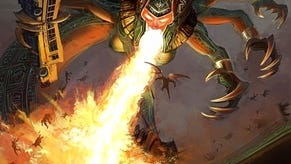Overlord II
Do know evil.
If you're one of the few people who got to the end of Overlord 1, you might be wondering how there's a sequel at all, what with the actual overlord being dead and that. Fortunately for lovers of pure evil, this is a videogame, so it turns out he had a son, and just as said tyke was about to fall into the clutches of the ruling Empire, he was rescued by scaly, big-eared minions who recognised him as their new master. Problem solved! Several years later, he's got his own Dark Tower, and once again it acts as the game's base of operation, from which players launch a guerrilla campaign against the boringly nice Empire.
So far, so Overlord, but as much as we loved the first game (and its Raising Hell expansion), even its most bedeviled admirers agreed it wasn't evil enough. We didn't want to stop at laying waste to the land and slaying its populace; we wanted to leave citizens cringing at our all-conquering might, and begging for mercy. We wanted to laugh with a roar that would have Brian Blessed cowering in the corner. So it's good to discover, as we tool around Triumph Studios getting to grips with the sequel, that the developer got the message.
One of the key changes to the strategy-adventure gameplay is that the choices aren't simply about good or evil. After all, you're a cackling Overlord with a giant sword, fearsome armour and a horned helmet; the concept of good doesn't enter the equation. As Triumph's creative director Lennart Sas explains, the premise of the sequel is unfettered tyranny. Players now choose between shades of evil; do you choose the cold-hearted enslavement of domination, or down and dirty demonic destruction?

Whichever you choose ultimately has a bearing on how you play the game thanks to the spell system. "If you become a dominating tyrant, your spells will become better at subjecting the populations to your evil will," explains Sas. "Controlling a town of brainwashed slaves gives more benefits spread out over time, while destroying a town gives instant evil gratification: the souls of the slain population and looted treasure from their destroyed houses are for the taking."
The core gameplay remains rooted in the Pikmin-meets-Sacrifice action-strategy template of the original, however. Once again you control the Overlord in a typical third-person action-adventure fashion with the left stick, and sweep the evil minions around the screen with the right. For the majority of the time you don't have to get your hands dirty, but let the cackling Gremlins-escapees do your bidding - usually with amusingly demonic results.
Once again there are four types of colour-coded minions. You can still rely on the same base abilities, so Browns are your best melee fighters, Reds are your best ranged weapon with their fireball-lobbing abilities and resistance to fire, Greens bestride toxic areas and sneak around, while the Blues are great healers who can cross water. Where it gets interesting is the minions' ability to mount other creatures, adding an extra layer of abilities.

So, Browns can now ride wolves and form a fast and vicious cavalry charge. Not only can they travel faster than before, but they can jump gaps, knock over opponents and cause greater damage with their ferocious bite. Reds, meanwhile, get to ride fire salamanders. Described as "living flamethrowers" they will be capable of shooting out concentrated fire blasts, as well as be able to "dig into gnome holes to chase out the little buggers" and snaffle their goodies. The spider-riding Greens will now be able to ascend walls and web-up enemies like Spider-Man. Blues, however, miss out on the whole mount party. Sniff.
In addition to these new abilities, you'll also be able to command a Minion Champion, who can lead groups of more than ten minions into battle. Taking a leaf out of Cannon Fodder's book, your minions now have an identity of sorts, so hopefully you'll become more attached to them, and later in the game you'll even come across a minion graveyard and be able to resurrect your cherished commanders.



